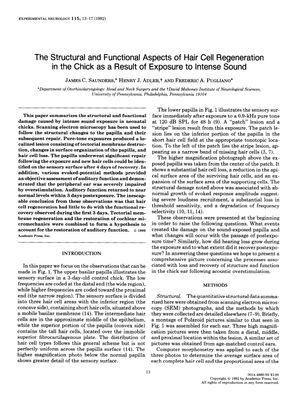The structural and functional aspects of hair cell regeneration in the chick as a result of exposure to intense sound
January 1992
in “
Experimental Neurology
”

TLDR Chickens exposed to loud noise can quickly regain hearing mostly due to repair of the tectorial membrane, not just hair cell regeneration.
In 1992, Saunders, Adler, and Pugliano studied the damage and regeneration of hair cells in the basilar papilla of neonatal chicks after intense sound exposure. They found that pure-tone exposures caused localized lesions and hair cell loss, but significant repair and new hair cell identification occurred within 4 days. Despite this, auditory function, which was severely impaired, returned to near-normal levels within 3 days, suggesting that hair cell regeneration was not the primary factor in early functional recovery. Instead, the regeneration of the tectorial membrane and restoration of cochlear micromechanics were hypothesized to be responsible for the rapid recovery of hearing. The study indicated that the tectorial membrane's condition is more closely related to hearing loss and recovery than hair cell replacement. The authors proposed that either direct damage to tall hair cells or damage to the mechanical input to these cells could explain the loss and recovery of auditory function. Despite little recovery in hair cell density and supporting cell surface area, substantial recovery of auditory functions occurred within the first 72 hours post-exposure, with significant repair of the tectorial membrane observed, highlighting its role in the recovery process. Further investigation into these hypotheses was acknowledged as necessary.